..."if land is held as a source of profit, that opens a certain pattern of reactive behavior which is very well-established. It has led to ecological disaster which is growing worse and worse. It seems from the psychological, theological and sociological point of view to name God as grantee will bring out the best in anyone who is who feels a custody over this land. How really should we live on the earth when we are not concerned at least with this tiny, little pilot study with maximizing the net?" (Lou Gottlieb)
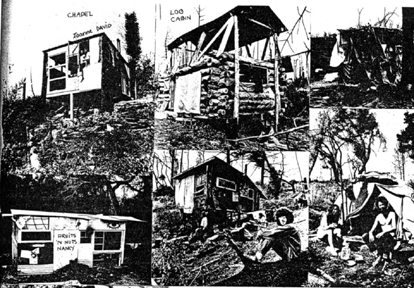
On Oct. 10, 1968, Lou Gottlieb, owner of some 31 acres north of San Francisco came before his local Board of Supervisors to offer his property to the people of Sonoma County "as an experiment in living." In his proposal, Gottlieb elaborated upon the advantages of opening land to free access, citing his experiences with the self-organizing and healing that occurred during the years since his land was opened to all comers. He argued that free access to the land would correct "the territorial imperative" which generates conflict, and asked the Supervisors to support a pilot study, followed by a county referendum which would decide conditions of the county's acceptance of the land. Continuing, Gottlieb described "a new town that would be designed by the people who live in it and marked by folk architecture."
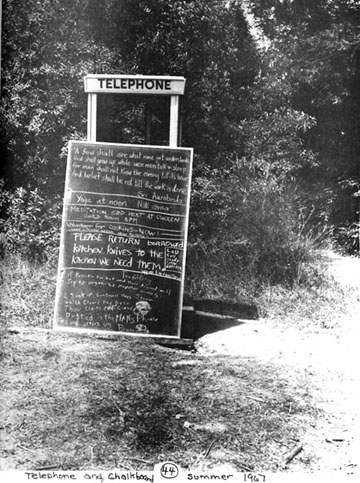
The story of this "experiment in living" is documented in Home Free Home, Ramon Sender's online account of two 60s open land communes- Morningstar Ranch and Wheeler's Ranch . Through interviews and anecdotes, former residents describe a period of time without social or economic rules or boundaries. The experience at these former communes carried such impact that members maintain ties through a list-serve that provides a stream of contact and support for present day concerns: politics, spirituality, healthcare and open land. Their accounts of self-organized rural life meet and exceed the stereotypes of Northern California hippie culture preserved by period photojournalism: long-hair, 'free' sex, hallucinogens, hedonism and hepatitis. While every close-up offers an alternative view, I think these narratives about open land reveal an approach to the political that was, and continues to be invisible to a political and cultural movement fragmented by geography, political strategy, and perceptions of style.
"Land Which Can Be Denied to No One" can be read as a critique of property that was overshadowed by the spectacular affect of national socio-political movements whose anti-authoritarian goals it shared. In Gottlieb's last days in court, the effort to keep 31 acres open for anyone exposed the muddle of contradictions underlying American society and law, striking a poetic chord in spite of, or perhaps because of the impossibility of Morningstar's call for a society inspired by learned ethics, security and love. Can we claim political aspirations for a movement persistently coded as apolitical, even infantile- from the outside (certainly in comparison to the militant engagements of Maoist and socialist organizations of the time), but also from within while there were many names for what Morningstar hippies were practicing, they were reluctant to separate out the political from whole experience, contributing to an impression this was yet another capitulation of politics to lifestyle.
"Worke together, Eat bread together, declare this all abroad." - Gerard Winstanley from a vision (1649)"Morning Star Diggers will swap work and organic vegetables for what have you. Diggers are determined to find a way of living that's human, person-to-person. Money makes life impersonal. It's our hope at Morning Star to establish a system of barter with our neighbors." - from a sign at a local Sonoma County store, circa 1967
The land's owner and eventual advocate of its liberation, Lou Gottlieb, was bass player with the successful Limeliters folk group. He bought it as an investment but felt differently after meeting Ramon Sender, a composer and co-founder of the San Francisco Tape Music Center. Ramon wanted to start an ashram and after he moved up there, others, including Lou, joined him. There was an orchard there, and in 1966 a box of apples was left at the Diggers Free Store in the Haight, along with a map and invitation to the land.
Morningstar's proximity to San Francisco meant people didn't have to fully commit to going "back to the land." People could visit for a couple days to check it out, and weekends found several hundred munching on brown rice prepared by full timers. With 31 acres to distribute their bodies, wastes and vocal chords, there was a relaxed attitude toward visitors. As more people appeared, however, Gottlieb felt cause to turn away a disturbingly noisy woman, and as he was preparing do so, he experienced second thoughts in the form of a vision.
He became convinced that he didn't have the right to send anyone away, ever. People stayed as long as they wanted, negotiated few rules, and debated or ignored issues like land capacity, where to crap, how to wash and other matters of interest to the authorities. Over time, these same issues became subjects for confrontation by adjacent property owners who found hippies offensive. Complaints were soon registered with the County for everything from the smell of poorly buried feces to what was, for one neighbor, the unimaginably horrifying sight of 10 naked men standing on their heads.
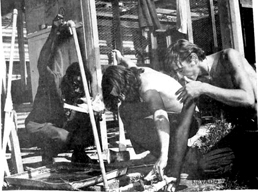 By 1968, Gottlieb faced eviction by the County and owed thousands in fines for improper sanitation, for maintaining an unlicensed 'organized camp,' and for trespassing on his own property. "I always thought this was a disorganized camp," quipped the comedian. For over two years, residents were repeatedly hauled into jail for sleeping on the land, or had their shelters bulldozed, bringing the question of the rights of a private landowner on his own land up for public inspection and debate. Gottlieb remained indomitable to the end, generating creative tactics from love (visiting the neighbors who signed a petition against them) to trying to bequeath the land to the county, and finally deeding it to God. Throughout the debacle, the joyfulness of the full time residents continued to seduce visitors; one county inspector mentioned to his mates there was a chance he might just defect.
By 1968, Gottlieb faced eviction by the County and owed thousands in fines for improper sanitation, for maintaining an unlicensed 'organized camp,' and for trespassing on his own property. "I always thought this was a disorganized camp," quipped the comedian. For over two years, residents were repeatedly hauled into jail for sleeping on the land, or had their shelters bulldozed, bringing the question of the rights of a private landowner on his own land up for public inspection and debate. Gottlieb remained indomitable to the end, generating creative tactics from love (visiting the neighbors who signed a petition against them) to trying to bequeath the land to the county, and finally deeding it to God. Throughout the debacle, the joyfulness of the full time residents continued to seduce visitors; one county inspector mentioned to his mates there was a chance he might just defect.
The final arguments made in court for the validity of God as a recipient of the land reads like deliciously suspended theater, like Beckett perhaps, with the prosecuting lawyer arguing that they should not have to wait any longer since the deity on the deed hasn't the ability to sign. The judge decorously allowed Lou and his lawyers to read arguments for God as beneficiary, but ultimately refused to stay the injunction that forced them to leave the land. With humor and passion, Gottlieb exposes the absurdity of a state under God under which God has no claims.
All space is already occupied by the enemy, which has even reshaped its basic laws, its geometry, to its own purposes. Authentic urbanism will appear when the absence of this occupation is created in certain zones. What we call construction starts there. It can be clarified by the positive void concept developed by modern physics. Materializing freedom means beginning by appropriating a few patches of the surface of a domesticated planet from Basic Program of the Bureau of Unitary Urbanism by KOTÁNYI and VANEIGEM 1961Men have unrealized potential for self-cultivation, self-direction, self-understanding, and creativity. It is this potential that we regard as crucial and to which we appeal, not to the human potentiality for violence, unreason, and submission to authority. (Port Huron Statement, 1962)
This was not the society that was going to change the world. This was the society that was in itself changing. Tomas Diaz (former resident of Morningstar)
Before injecting posteriors with massive doses of vitamin B-12, doctors should recommend a three-month stay in Alternate Society. (-- Lou Gottlieb, quoted in court by the Sonoma Press Democrat, Oct. 5, 1968
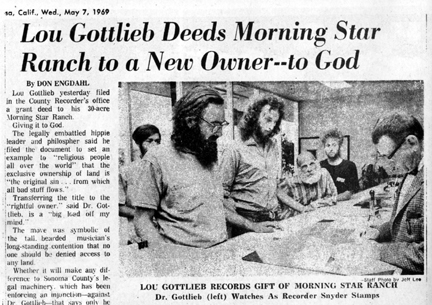
This retreat was not an enclosure. While the call of open land found individuals seeking dawn meditation, brown rice and sacramental drug use, it also beckoned urban subjects who were harrassed for what today would be called quality of life crimes. The parking lot was dominated by winos, and throughout the property wandered a miscellany of the unstable, asocial or simply clueless abandoned in the increasingly predatory atmosphere on Haight Street. Open land functioned as a geographic pressure valve, a messianic compensation for the uneven development of the city. Ramon Sender writes, "We had dudes come up edgy and aggressive, and a few days later I'd see them smiling and relaxed. Living close to Nature is the best therapy one can receive, especially surrounded by loving and accepting brothers and sisters." Morningstar people regarded the problems of dysfunctional newcomers as symptomatic of larger social failings, and offered these individuals fraternity and the space needed to heal their mutilated psyches, a zone for recovery. In trying to locate the political legibility here in relation to a larger movement at the time- and to its historical treatment, I think these expressions of concern for an Other outline a denigrated sort of political expression that sublimates individualism.
In analyzing how historians have recorded the 1968 general strike in France, Kirsten Ross notes that individual narratives tended to obscure the reality of political cross identification between workers and students. "May 68 had very little to do with.. the students or youth who were its instigators. It had much more to do with the flight from social determinations, with displacement that took people outside of their location in society, with a disjunction that is between political subjectivity and social group." There was an effacement of identity in favor of communal goals that is now missing from the record, what she calls "a shattering of social identity that allowed politics to take place."
Ross emphasizes how the strike reflects a unity of response and action across a large part of the population. In the United States, anti-authoritarianism was expressed through multiple strikes, actions, postures, retreats, programs and occupations. Our social histories are too diverse, and the geography too immense to approach the coherence of over 9 million French people striking for a month. It is nevertheless tempting to look for corollaries in the US experience. Ross' observation of the movement's fragmentation by the individualization of experience certainly sounds familiar. What is typically preserved as the legacy of these years of dissent and organization in the United States? The progressive programs sponsored by the Black Panther Party in dozens of African American communities were largely sabotaged by government infiltration. The five-month strike at San Francisco State College resulted in academic reforms such as Black and Ethnic Studies. Much of what survived the 60s did so in forms that could be assimilated by the status quo. These reforms admitted minor changes in lifestyle that would ultimately function as handmaidens to a progressive modernism and, concomitantly, commodity forms.
The population of the United States got liberated sexual norms, food coops, and a Breakfast for Children program run by the government instead of a community. In narratives, popular memories of the left tend to be fragmented by social identities based in geography, class and color. The alliances that did exist are found only through sustained research.
On the surface, the San Francisco scene in particular was indulgent and frivolous, and in 1967, the sight of unkempt masses of runaway teens was an abject and sensational image that drew a large share of publicity and media coverage, certainly obscuring a lot of detail.
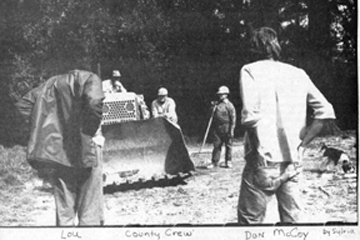

San Francisco's Summer of Love gets celebrated especially for its own colorful display, a rainbow of orgasmic freedom separated out from its arousal and detumesence. By dint of association- location and favored chemicals, Morningstar was part of this "scene". Morningstar people were eager to be part of this publicity; excited to exhibit and share their commitments to a lifestyle of voluntary primitivism, and trusting of the writers and photographers who mediated their lives for public exposure. They saw their reduced consumption as an answer to the degrading and exploitative forces of capital, and they were very interested in circulating this awareness. The outrageous aesthetics and sensuality of the hippies, and their practical integration of the political made it easy for the media to ease these stories of social dissent into lifestyle sections. But even as the prissy journalists sniffed at the dirt, and Haight Street shops pushed tie-dye, the Land Which Can Be Denied to No One continued to offer safe haven for those who could find it.
"One young man who read the article as an inmate of a New York mental hospital. He split for Morning star same day.." Society's problems were coming to the Divine Mother to be healed, and no one was willing to stand in the way of whatever it was that was happening." From Home Sweet Home (Sender p. 10)Conversations on the list-serve recently turned to the subject of mental health people writing about how damaged and traumatized they were when first arriving at the ranch, or about abuse suffered at the hands of their parents, fathers, families, the state, the economic system

C: "Back when we were trying to figure out what Morningstar was, R. suggested "Uninursery."
P: "Ooh! That's a good one, C!" "Maybe a de-tension center"
These cornball puns make light references to the labor of nursing and healing, work traditionally unseen and under-appreciated, the 'immaterial' labor Negri and Hardt describe as "labor-as-service." If what the people at Morningstar were doing was confronting internalized structures of power and authority, can we imagine these efforts as coherent with the political aspirations of the left? If so, might there be a tendency to consider this immaterial labor to be less political- less masculine, active or quantifiable than the labor of fighting police barricades or publishing? I wonder if the political legacy of this moment gets lost after being processed through a normative calculus of labor that discredits work that is invisible and feminized.
Similarly, Gottlieb's attempt to raise a religious defense for open land is viewed dismissively by contemporary scholars and land activists seeking ethical boundaries on property rights. Perhaps this defense isn't so absurd in context; a few years earlier, a defendant won the right of conscientious objection from the war service based on religious beliefs, and a year later, another Supreme Court ruling allowed personal ethics alone to trump belief in a Supreme Being in a CO case. (10)
While attempts to legally designate the land as "open" at Morningstar and Wheelers failed in court, this obstinate yearning for an outside of the commodity system still made it an effective incubator for ministering to a new consciousness. Gottlieb is not nuts in saying territorialism creates conflict. As a critique of property, Morningstar was neither academic nor militant as much as a circumstantial adjustment to geographical economics abetted by hallucinogens and other boundary-dissolving practices: meditation, yoga, dietary adventurism, and Digger idealism. This critique of property was stumbled into like an apparition of Mary on a tortilla, like falling into the earth itself. With optimism and ineptitude, Morningstar residents discovered something about what it means for humans to live on land, the deepening knowledge of place they never had had the opportunity to experience. Once this experience made its mark, residents needed to share it, regardless of the consequences.
After several years in and out of prison and thousands paid in fines, Gottlieb proclaims "I urge anyone who owns land and wishes never to again to experience one instant of boredom, who wishes to live in a continuing state of elation, to deny no one access to that land and watch what happens."
Sarah Lewison
San Francisco, spring 2006
for corrections of record or discussion please write sarah at
sacamixta at gmail dot com
published in "Failure," Journal Press:2006
footnotes
1 Sonoma Press Democrat ca early 1968
2 This was a 320-acre property owned by Bill Wheeler which opened its doors in 1968, following the injunction against habitation at Morningstar. Wheelers continued to be the home of ex-Morningstar residents and others until it was also challenged by the county. The residents at Wheeler¹s Ranch also tried a religious defense in maintaining open land, claiming first amendment rights to establish a religion based upon open access to the land. For reasons of length, this essay concentrates on Morningstar.
3 Winstanley elaborates his vision in The True Levellers Standard ADVANCED : OR, The State of Community opened, and Presented to the Sons of Men.
4 SFTMC was founded by Mort Subotnick and Ramon Sender in 1962 and is central to the history of taped and electronic music. Other well-known composers involved there include Terry Riley and Pauline Oliveros.
5 When Lou Gottlieb, Ramon Sender and their partners moved to the ranch, they were joined by filmmaker Bruce Baillie and Berkeley¹s Open Theater Gallery directors Ben and Rain Jacopetti. Many of the first residents were artists for whom an abundance of space provided time to pursue creative interests.
6 "Morningstar Ranch served as a free treatment center for LSD-overdosed people that the Digger bus delivered without charge from the Haight-Ashbury, as well as society's serious alcohol abuse cases." Ramon Sender, from a San Francisco Chronicle Sunday Book Review, March 3, 2003 of TC Boyle¹s Drop City.
7 Kirsten Ross, May 1968 and its Afterlives, University of Chicago Press, Chicago (2002)
8 Strikers won higher minimum wages, reduced hours and the right to organize.
9 Hardt and Negri, Empire, p. 290
10 Seeger v. United States (03/08/65) and Welsh v. United States. (Argued: January 20, 1970 --- Decided: June 15, 1970)
Photo credits: The Friends of Morningstar.
Additional resources:
Home Free Home: A History of Two Open-Door California Communes by Ramon Bayaron Sender and others http://www.diggers.org/homefree/hfh_09.html
Roots of Communal Revival 1962-1966 by Timothy Miller: http://www.thefarm.org/museum/communes.html
San Francisco State College Strike: http://www.library.sfsu.edu/strike/
Back